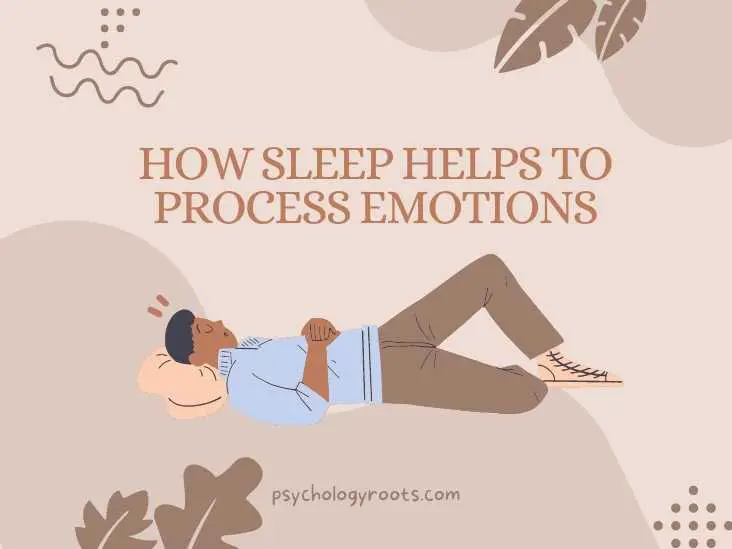Table of Contents
How Sleep helps to Process Emotions
Here in this post, we are discussing and learning about “How Sleep helps to Process Emotions”. You can read more about psychology-related material on our website. Keep visiting Psychology Roots.
While dreaming, scientists from the University of Bern’s Department of Neurology and University Hospital Bern have discovered how the brain prioritizes happy and negative feelings in order to strengthen the preservation of pleasant emotions. The findings of this study expand on the significance of sleep for mental health and provide new possibilities for treatment.

How Sleep helps to Process Emotions
REM sleep, also known as paradoxical sleep or rapid eye movement sleep, is a peculiar and mystifying kind of sleep in which the majority of dreams include high emotional content. It’s not quite apparent how and why these feelings are reawakened in the first place. During waking, the prefrontal cortex integrates many of these emotions, but during rapid eye movement (REM) sleep, it seems to be quiet. We set out to discover the mechanisms and functions that underlie such a bizarre occurrence, explains Prof. Antoine Adamantidis of Bern’s Department of Biomedical Research (DBMR) and the Inselspital’s Department of Neurology.
Survival of the fittest requires animals to be able to process emotions, notably the ability to discern between danger and safety. Pathological conditions such as Post-Traumatic Stress Disorders (PTSD) may develop in people who experience extremely unpleasant emotions, such as dread and worry (PTSD). Anxiety disorders and other serious mental illnesses impact around 15% of Europeans. New insights into the brain’s role in reinforcing good emotions and weakening highly unpleasant or traumatic feelings during REM sleep have been gained by the study group led by Adamantidis. In the journal Science, the researchers reported their findings.
A Dual mechanism
Mice were initially trained to distinguish between sounds associated with safety and those associated with danger by the researchers (aversive stimuli). When the mice were asleep and awake, they had their brain activity monitored. As a result of their work, the scientists were able to discover how the brain processes emotional memories during REM sleep.
neurons are made up of a cell body (soma) and axons, which convey messages to other neurons through their dendrites (inputs) (outputs). While dendrites are stimulated, the cell’s soma remained quiet, according to the data obtained. Soma is “wide awake” and dendrites are “wide awake,” says Adamantidis. “This signifies a dissociation of the two cellular compartments,” he continues. During REM sleep, the dendrites’ high activity permits the encoding of both danger and safety feelings, but the soma’s inhibitions entirely block the circuit’s output. So, the dendrites of the brain favor the ability to distinguish between safe and dangerous stimuli, but they inhibit the over-reaction to emotion, particularly fear.
A survival advantage
First author Mattia Aime believes “this bi-directional system is crucial to maximize the distinction between harmful and safe signals,” which is why both methods are advantageous to organisms’ survival. Anxiety disorders may develop if a person lacks the ability to discriminate between normal and abnormal fear responses. Pathological illnesses such as post-traumatic stress disorders, in which trauma is over-consolidated in the prefrontal cortex during sleep on a daily basis, might benefit greatly from these results.
Breakthrough in the field of sleep medicine
A deeper knowledge of how people absorb emotions while sleeping may be possible as a result of these results, as well as new treatment avenues for treating conditions such as Post-Traumatic Stress Disorder (PTSD) and its sleep-dependent consolidation. Acute or chronic stress, worry, despair, panic, or even anhedonia, the inability to experience pleasure, may be associated with this somatodendritic dissociation during sleep. The Inselspital, Bern University Hospital, and the University of Bern have long been active in the fields of sleep research and sleep medicine. According to Adamantidis, “We hope that our results will not only be of interest to the patients, but to the wider public.”
Summary
Scientists from the University of Bern have discovered how the brain prioritizes happy and negative feelings in order to strengthen the preservation of pleasant emotions. Rapid eye movement sleep or rapid movement sleep is also known as paradoxical sleep. Findings expand on the significance of sleep for mental health and provide new possibilities for treatment. Neurons are made up of a cell body (soma) and axons (dendrites). While dendrites are stimulated, the cell’s soma remained quiet, according to researchers at the University of Bern in Switzerland. Soma is “wide awake” during REM sleep and dendritic activity permits encoding of both danger and safety feelings.
Help Us Improve This Article
Have you discovered an inaccuracy? We put out great effort to give accurate and scientifically trustworthy information to our readers. Please notify us if you discover any typographical or grammatical errors.
Make a comment. We acknowledge and appreciate your efforts.
If you have any scale or any material related to psychology kindly share it with us at psychologyroots@gmail.com. We help others on behalf of you.